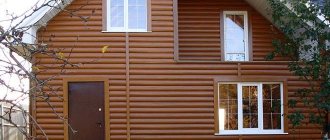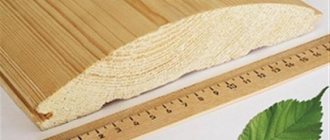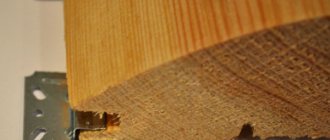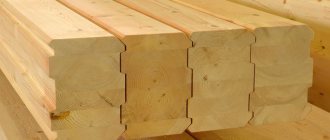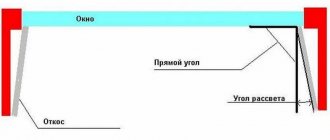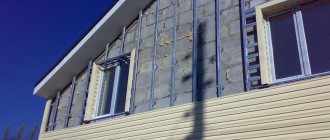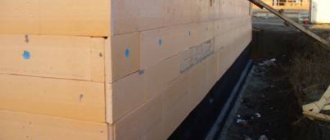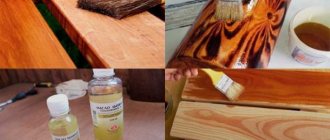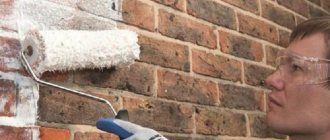Recently, many private developers have given preference to natural building materials, such as wood. The use of wood in the construction of residential buildings has always been considered a sign of good taste, even if only the finishing is made from it. However, not all homeowners are ready for the fact that wood needs to be protected and the coating periodically renewed. How to treat a house block so that it is not damaged by fungus, mold, or insects, and to increase its service life?
What is a block house?
Block house (translated from English as “house element”) is a modern wood finishing material that resembles a log structure from the outside. In fact, it is a type of planed board or lining, that is, a panel that is a segment of a rounded log or profiled beam. Made from hardwood of the best quality (aspen, pine, larch, spruce, birch, linden). It is used with equal success both for exterior decoration of the facade of a house and for interior decoration.
You can cover a block with a house on surfaces made from almost any building material: brick, aerated concrete, foam blocks, wooden beams, etc. If necessary, a layer of sheet or roll insulation is placed under the sheathing. The panels are mounted on an additionally installed vertical sheathing, and the connection is made using grooves and tongues cut on a milling machine. Thus, the cladding is a monolithic layer that is not afraid of wind, snow, or rain.
The house block is made from 2 to 6 meters in length, the width of the front decorative surface is from 90 to 190 mm. The thickness of the material is indicated at the most convex point from 20 to 40 mm. Interspersed knots, wormholes, resin pockets and microcracks (up to 1-2 mm) are allowed.
Manufacturing processing
Most manufacturers who produce block houses for exterior wall decoration try to improve its quality as much as possible. For this, various coloring, antiseptic and water-repellent impregnations are used.
The entire processing process takes place in large industrial machines (pressure chambers), since it is quite difficult to do such work manually. This technology allows the composition to penetrate deep into the wood and maximally protect the building material from fire, rot and harmful insects.
The production processing of a block house is divided into several stages:
- First, the manufacturer chooses what to paint the block house with; this can be either impregnation or a decorative coating, for example, paint.
- This is followed by the displacement of moisture and air from the prepared wooden blocks using a vacuum apparatus.
- After complete drying, a reagent enters the chamber, which will serve as protection for the building material. Under high pressure in a pressure chamber, the logs are impregnated with the composition (the exposure time is selected individually for each type of wood). The depth of impregnation is observed in accordance with established GOST.
- Excess protective impregnation is removed from the chamber, and the house block is subjected to repeated vacuum treatment. In this way, residual moisture can be removed from the surface.
- At high atmospheric pressure and temperature, the protective coating dries completely and is fixed on the blocks.
If you plan to cover the façade of your house with a block house yourself, professionals recommend choosing panels that have already been treated with a protective compound. They are easy to install on the wall surface and do not require additional painting.
Features of the material
The service life of such material is approximately 12-15 years, and repair work consists of updating the decorative layer.
How to treat a block house if it was received raw?
There is simply no definitive advice for finishing exterior carpentry. This material is very specific, capricious, of biological origin (and different breeds have their own characteristics), which means it suffers differently from moisture or drying out, ultraviolet rays, mechanical stress, pests, drying conditions and speed, and other factors.
Initially, it is necessary to study the condition of the wood (since most buildings turn gray and are affected by pests even at the construction stage), then select the necessary paints and varnishes. Treat the planks, sheathing and base (if it is also wooden) before facing, let it soak well, attach and paint with a decorative layer. So it is quite possible to cover a block house with high quality with your own hands and it will last no less than one processed in a production environment.
How to apply impregnating preparations
Many craftsmen are still arguing about how it is more convenient to apply impregnation to a block house: before or after installation on the walls of the house. Each method has its own disadvantages and advantages:
- By treating the panel before installation, you can evenly paint all surfaces, but during installation, chips or other mechanical damage often occur, which will allow moisture to pass through and thereby reduce the quality of impregnation.
- If the impregnating mixture is applied to the facade or inside the house after installing the panels, this method guarantees uniform coloring. But drips may occur.
Before you begin, you need to prepare the following tools:
- brushes for painting cracks, joints and other hard-to-reach areas;
- rollers for uniform distribution of the selected impregnation over a large area;
- If desired, you can use a spray gun for some solutions.
Surface preparation before impregnation plays an important role. The final result of the work depends on the quality.
Necessary:
- Thoroughly clean from dust and dirt, if possible, rinse with clean water.
- If varnishes or paints have already been applied to the panels, then their remnants must be removed using a metal brush or drill with special attachments.
- Treat the cleaned and dried surface with white spirit or other alcohol-containing compounds.
After such preparation, you can apply the impregnating mixture to the panels inside or on the facade of the house, evenly distributing the composition over the surface. If necessary, repeat the procedure after the first layer has dried.
A residential building clad in a block house can look like a country cottage or a cowboy ranch.
It all depends on taste and desire. If you provide long-term protection to the cladding panels, then in such housing you can relax for many years after a hard day’s work or comfortably spend weekends with family and friends.
Recently, many private developers have given preference to natural building materials, such as wood. The use of wood in the construction of residential buildings has always been considered a sign of good taste, even if only the finishing is made from it. However, not all homeowners are ready for the fact that wood needs to be protected and the coating periodically renewed. How to treat a house block so that it is not damaged by fungus, mold, or insects, and to increase its service life?
Processing of block house at the installation stage
To protect the exterior of carpentry, preserve their external beauty and extend their service life, it is recommended to treat them with paints and varnishes before starting installation work. For these purposes, all kinds of stains, varnishes, paints, glazes, impregnations, drying oils, etc. are used.
How to cover a block house if preference is given to the natural structure of wood?
Transparent varnishes and glazes will help in this matter, while tinted opaque paints, on the contrary, will hide all the imperfections of the wood and fit into the style invented by the author.
Impregnations are used to protect wood from fire, bad weather and pests.
- Water-soluble acrylic impregnations
are intended for coating fresh wood, do not have a strong toxic odor and can be used for painting indoor surfaces, even while residents are living. - Alkyd impregnations based on resins
create a more resistant, durable and high-quality coating, but have a pungent odor and are intended for outdoor use. - Oil products
are made on the basis of flaxseed oil (or any other natural oils). A durable coating that has long been time-tested, but takes quite a long time to absorb and dry. After oil impregnation of the house block, decorative finishing with some paints will be impossible!
Stains leave the grain of the wood unchanged, but change its shade, usually to give the color of a different species. It is applied to the treated surface, penetrates inside, dries without forming a film or smooth layer on the outside of the surface.
Stains can be water-based, solvent-based (nitro stain), wax-based, or alcohol-based. The latter almost always have protective qualities. You can also paint the block house with a colorless stain, which is intended solely to protect the wood and the primer.
Expensive processing
To protect a new design from most risks, it is necessary to use only proven and best materials.
Don't know what to paint the outside of a blockhouse with? One of the most popular methods is the use of azure. This special composition can be mixed with the tint and then applied to the wood surface.
Unfortunately, it is quite difficult to accurately guess the shade that will result, but it is guaranteed to change the color of the wood. It is better to conduct several experiments before using such a mixture on the main structure. In addition, glazes perfectly protect wooden structures, give expressiveness to the texture and withstand various temperature and weather influences for a very long time.
Decorative covering of block house
Varnish and paints.
They cover the wood with a dense layer that reliably protects them from bad weather and the influence of sunlight. Varnishes are usually colorless or can slightly change the shade of the material, while paint is designed to change color (can be matte, glossy or semi-matte). For better adhesion of facade paints to a wooden base, it is recommended to coat the working surface with a specialized primer, preferably from the same manufacturer as the paint.
During use, varnishes and paints may crack or begin to peel, then to restore the coating it will be necessary to remove (sand) the entire layer down to the base and only then paint again.
Azure.
Create a thin moisture-proof film on the coating. A significant difference between glaze and varnish is that they, like impregnation, penetrate deeply into the thickness of the wood.
Transparent azures are designed to highlight the noble texture of the material. Decorative, imitating shades of different types of wood or slightly tinted, allow you to process surfaces instead of the usual oil or acrylic paints. Water-repellent glazes (alkyd, alkyd-oil, acrylic-oil) protect the facade from weather conditions, ultraviolet rays, rotting, as well as mechanical damage (alkyd-urethane glazes).
Wax.
Traditional natural coating, light-repellent, waterproof, with a specific matte shine. To update the layer, it will be necessary to remove the coating to the base. It is recommended for interior work, but some brands are also intended for treating facade walls. It is not always possible to paint a wax coating with paints or enamels.
You can process and paint the house block with any roller or brush, the main thing is that the working surface is dry and free of dust, dirt, old paint or varnish. Coating options are selected based on personal preferences, wood condition, operating conditions and budget. It is recommended to cover areas of increased mechanical stress with an additional 1-2 layers of coating or varnish, but from the same manufacturer as the main paint and varnish.
If a wooden block house is used as decoration for the house, then the building looks very nice. Presentation is not the only advantage of the material, which is why consumers make a choice in its favor. But there is a second side to the coin: the tree needs to be protected. Finishes made from it can become a victim of house fungus or insects. Therefore, a logical question arises for those who decide to use the material: how to treat the outside of the block house so that it lasts as long as possible. A considerable amount of impregnation will help protect wooden panels, and therefore increase their service life. The question can also be posed this way: how to paint the outside of a block house, because this material can be coated with coloring compounds that change its natural color.
How to paint a block house outside - surface preparation
Whatever composition you choose, before painting the block house, you must definitely follow the procedure for preparing the material. The wood must be cleaned of remnants of previous compounds, if any, as well as dirt and dust. Cleaning is carried out using grinding machines, steel brushes or, in extreme cases, a knife.
Mold-covered and darkened areas should be pre-treated with bleaching compounds - this is if you want to emphasize the texture of the wood. If you cover the material with colored paint, then these imperfections will be reliably hidden from human eyes.
It is most convenient to work with a block house using two tools at once - a roller and a brush. A large area is treated with a roller at once, while with a brush the coloring composition is applied to hard-to-reach places. Prepare enough rags and a paint bath for work so that it is convenient to apply the composition to the roller.
- Author: Mikhail Malofeev
Rate this article:
- 5
- 4
- 3
- 2
- 1
(0 votes, average: 0 out of 5)
Share with your friends!
Products with transparent texture
Thus, the answers to the question of how to paint a block house outside and for interior decoration can be very different. All products have their own advantages, all have nuances of application. And only after studying all the available options can you begin to change the “appearance” of the room.
Ekaterina Nevzorova, Minsk, 2014
- Should you choose wooden decorative panels? Or should you still choose a vinyl block house for a log? This question arises before everyone who decides to cover the facade with cladding...
- A metal block house under a log is made of galvanized metal. Using special technologies, it is coated with a special polymer...
- Insulation of the walls of a house from the outside is necessary, regardless of the material used (wood, foam block, brick, reinforced concrete, and so on). To complete this process, in any case, you must...
- Houses made of wood are buildings that are distinguished by their reliability, aesthetics and environmental friendliness. Despite the simplicity and naturalness of the material, structures made from it are quite expensive and affordable...
- Once upon a time, there was only one answer to the question of what kind of block house there is. At the dawn of their existence, the panels were exclusively made of wood, and only then they began to be made...
The smart ones came up with it, practice showed it, and a nice person posted it, I’m just quoting... and thanks to them all
Antisepticize unpainted wood On a similar forum, one guy said - such (From: St. Petersburg): “Under no circumstances paint fences and wooden houses!This is a waste of time and money. It’s better to follow the wise experience of the Finns and prepare a special composition for coating wood.
Take 720 g of rye flour, 1560 g of iron sulfate, 360 g of table salt, 1560 g of dry lime pigment, 9 liters of water.
And now - attention!
When preparing the solution, it is important to follow the technology. Add flour to 6 liters of cold water and stir until a homogeneous mass with the consistency of thick sour cream is obtained. The paste is filtered and put on fire. Stir constantly, add salt, then iron sulfate and dry lime pigment. The remaining 3 liters of water are boiled and added to the resulting composition.
The consumption of this “paint” is 300 g/sq. m. Apply to wood twice. If your building or fence was previously painted with oil paint, it will have to be completely cleaned off.
After this painting, your building will last for 20 years without external repairs! The Finnish wood coating composition, unlike oil paint, is more durable and breathable.
Swedish recipe
Painting a house, whether big or small, is not a very pleasant pleasure: it’s hard, dirty, tiring. I didn’t have time to paint it - everything was peeling off again, the paint was hanging in tatters... And again - material costs. We need to get back to work. But we can’t not paint, because we do it not only for beauty, but also to protect the wood so that it doesn’t start to rot.
So the house painter dreams, sadly waving his brush, that scientists will come up with such a composition that once he paints, he paints forever...
By the way, there is such a composition. And it was not invented by scientists, but by the homeowners themselves, those who live in Scandinavia - Swedes and Finns.
To protect the wood, it is enough to paint the house just once. The wood will be reliably protected, and scraps of paint will not irritate you. True, the “color” will fade over time, but that’s another conversation. Let’s make a reservation right away: you can only paint with this composition clean wood, that is, wood that has not been painted before, or plaster. No pre-treatment is necessary.
Here is the lineup from Sweden. Just please, don’t take any liberties with the numbers. Do it exactly as it is written.
So: rye flour - 580-600 g, table salt - 250-260 g, drying oil - 240-250 g, iron sulfate - 250-260 g, red lead - 250-260 g, water - 4.5 liters. Dry pigments can be used to create different shades. The natural color of the composition will be yellowish.
The cooking technology is simple and accessible to everyone.
Pour rye flour with 3 liters of water. Place on low heat. While stirring, prepare the paste, making sure there are no lumps. When the paste forms a homogeneous mass, without removing from the heat, add salt and vitriol and continue to boil until the crystals are completely dissolved. Then add the red lead and knead the mixture until completely smooth.
Finally, pour in the drying oil, stir again and bring to the working volume (i.e. add another 1.5 liters of water), again without removing from the heat. The prepared solution is used for coloring immediately, while warm. After some time, it will begin to thicken, then you will have to dilute it with warm water, which is generally undesirable, because when the solution is “thinned,” the paint layer will become less durable.
It is more convenient to cover wooden surfaces with this solution with a brush, and plaster with a roller. The consumption of “Swedish” paint is approximately 250 g per square meter. _________________ “...In order to increase the level of general education...”
Modern finishing material block house can be used both for exterior decoration of the house and for decorating the interior, creating the illusion of a log house. Typically, manufacturers coat the block house with various protective agents - it becomes resistant to adverse environmental influences and does not require treatment for decades. But sometimes on the construction market you can find material that has not been treated with protective compounds. If you are “lucky” to purchase just this one, then you need to select a high-quality impregnation for the block house.
Types of paint - what is the best way to cover the surface?
To paint a block house, transparent and opaque coloring compounds are used.
Transparent paints contain pigment substances that enhance the effect of wood texture.
Transparent types of paint include:
- varnishes;
- impregnations (oil, acrylic, water-soluble, alkyd);
- glazing compounds.
It is not always advisable to use varnish for facade work, since, despite the good density of the coating and emphasizing the wood texture, not all varnishes are able to withstand aggressive environmental influences. In addition, varnishes are not able to maintain natural vapor exchange; they retain moisture, which can cause mold and rotting of the wooden surface.
Impregnations, unlike varnishes, are capable of providing vapor exchange and impart expressiveness and richness to the natural texture. The most popular are glazing agents that have the combined properties of varnishes and ordinary impregnations.
Glazing compounds reliably protect the coating from exposure to ultraviolet radiation and are also waterproof. For such colorless paints, you can use tinting of the composition by adding a small amount of dye to it.
This ensures the preservation of the wood texture and creates a decorative color design for the coating of a wooden block house.
Opaque paints include the following compositions:
- on organic solvents (oil, alkyd, acrylic, vinyl chloride, polyurethane);
- water based.
NOTE!
The most common are organic coloring compositions. The coating with such compositions is easy to apply and of high quality.
Alkyd compounds are especially widely used due to their low cost and ensuring the hydrophobicity of the coating. However, such coatings have their drawbacks: they are quite toxic and fire hazardous.
They protect well from external influences of acrylic-based paint.
Polyurethane compounds can create reliable protection for a wooden base and are the most effective in terms of wear resistance.
Requirements for the impregnating composition
To protect the finishing material from darkening, drying out, fungus or mold and preserve the beautiful structure of the wood, it must be covered with a protective layer. Impregnating compositions are divided according to their properties:
- Fire retardant - reducing the likelihood of fire. These compounds, applied to wooden panels, with a significant increase in temperature form a film on the surface that prevents combustion.
- Antiseptic - preventing the occurrence of fungi, rot or mold on wood. Some also repel mice and rats.
- Waterproof - preventing moisture and dampness from penetrating into the wood structure of the block house.
- Combined - combining several protective qualities.
For a residential building, it is advisable to purchase combined mixtures that reliably protect finishing panels from fungus, rodents and fire.
Painting technology
The essence of painting block house boards is to create a protective and uniform layer of paint on the surface.
A thin layer of paint is applied to the prepared surface: in hard-to-reach places - with a brush, on a large area - with a roller. Since the surface of the lining is not smooth, it is not always possible to cover the surface with a roller. In this case, you should use a sprayer.
After the first layer has dried, apply the second. Paint is applied from top to bottom.
If the painting of cladding boards is carried out before installation, then the boards, previously cleaned of dust, are coated on the outside, and also necessarily in the end parts.
CAREFULLY!
Painting of boards is carried out in several stages as each painted layer dries completely.
Often two coats are sufficient, but sometimes three coats are required.
Thus, painting a house made from house panels is not difficult. It is important to choose the right paint composition and prepare the surface well for painting. Thanks to the variety of paints on the market today, you can choose the right color for your home, which will help the building blend harmoniously into the surrounding landscape.
Types of impregnating compositions
When thinking about how to treat a block house outside or inside your home, you should keep in mind that the panels, thanks to their wood structure, are very beautiful. They do not need final painting (it is recommended to paint only an old block house that has lost its presentable appearance), so the impregnating compositions will also serve as a final protective coating. Depending on the purpose, the following protective and decorative impregnation solutions can be used:
- Alkyd ones provide complete protection from mechanical damage, repel mice and other rodents, but have a pungent odor. If treatment is carried out inside the house, care should be taken to ensure good ventilation of the room. They are very well suited for the facade of a house finished with a block house, providing it with long-term strength and reliable protection.
- Acrylic water-dispersion ones are environmentally friendly, but short-lived, suitable only for impregnating walls inside the house.
- Oil paints with or without tinting will help to significantly improve the decorative properties of wood, protecting it from destruction for a long time.
- Glazes are the most expensive, beautiful and durable processing option. Impregnation with glaze provides reliable protection from moisture, UV rays, rodents and insects, while maintaining breathability, providing the wooden surface with the necessary air exchange. Glaze compositions also highlight the unique wood structure, giving it a matte or glossy shine.
Do I need to paint wood flooring?
Most often, block house boards are used for exterior decoration
are treated with antiseptic and fire retardants at the production stage.
The deep penetration of protective compounds in autoclaves in production ensures the strength of even soft, inexpensive wood species, since the penetration of the protective compound into the board is ensured.
This ensures not only the strength of the board, but also eliminates the possibility of the spread of mold, mildew or insects in the natural material.
The category of inexpensive series boards can be produced without treatment with special compounds at the production stage. Such boards require additional coating with protective compounds or impregnation before installation.
Expensive panels do not require mandatory coating with protective compounds immediately after installation ; however, during operation, to maintain the wood in good condition, the wooden surface should be treated to prevent a decrease in its performance.
Self-processing steps
Preparing tools
Before painting the outside of a block house, you need to purchase the following tools:
- brushes and rollers;
- grinding tools;
- container for paint and varnish material;
- rubber gloves, safety glasses, respirator.
Do not use a sprayer to apply the protective coating. The composition will fall on the wooden surface in small drops; such application will not allow achieving a uniform texture.
Surface cleaning
The better the surface preparation is done, the stronger the protective composition will adhere. Therefore, before covering the block house with the selected composition, clean the base from dust, dirt and primary paint. To do this, use a wire brush or sandpaper. Using a grinder will make the task much easier.
Application of a protective composition
The coating must be applied in a thin layer to a previously cleaned surface. The blockhouse is painted using a brush on individual parts. In areas of increased mechanical stress, it is recommended to apply at least two layers of paint and varnish material, it is good if it is varnish. The composition must dry completely, after which you can begin installing the finish.
If the log materials are assembled into a single whole, then it is better to use a roller for painting, and paint hard-to-reach places and transitions with a thin brush.
